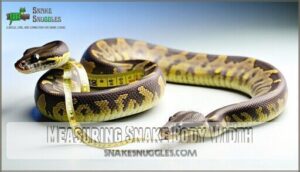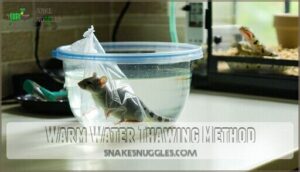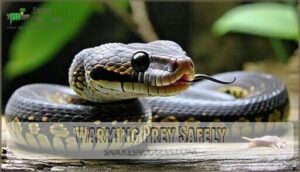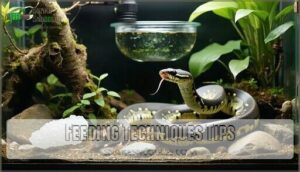This site is supported by our readers. We may earn a commission, at no cost to you, if you purchase through links.
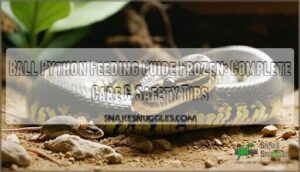
Feed hatchlings 10-15% of their body weight weekly, while adults need 5-7% every 2-3 weeks.
You’ll thaw prey in the refrigerator overnight, then warm it in hot water until it reaches 100-110°F, and the prey should feel slightly warm to touch, mimicking a fresh kill.
Never use microwaves – they create dangerous hot spots that can burn your snake’s mouth.
Watch for hunger cues like increased activity and tongue flicking, but don’t rush the process, as your snake’s safety depends on getting the temperature just right, and there’s a foolproof method that eliminates guesswork entirely.
Table Of Contents
- Key Takeaways
- Feeding Frequency Guide
- Prey Size Selection
- Prey Types Comparison
- Thawing Frozen Prey
- Warming Prey Safely
- Feeding Techniques Tips
- Ball Python Hunger Signs
- Avoiding Overfeeding Risks
- Frequently Asked Questions (FAQs)
- Is it better to feed a ball python live or frozen?
- How to feed a stubborn ball python?
- How to thaw snake food?
- What should I do if my ball python refuses food?
- Can ball pythons eat prey thats been refrozen?
- How long can thawed prey stay in the refrigerator?
- What temperature should my snakes enclosure be during feeding?
- Is it normal for ball pythons to fast seasonally?
- Conclusion
Key Takeaways
- Feed by age and weight: Give hatchlings 10-15% of their body weight weekly, while adults need only 5-7% every 2-3 weeks to prevent overfeeding and maintain proper health.
- Thaw safely, never microwave: Use refrigerator thawing overnight or warm water methods, then heat prey to 100-110°F using hot tap water to avoid dangerous hot spots that can burn your snake’s mouth.
- Watch for natural hunger cues: Look for increased activity, frequent tongue flicking, and exploratory behavior around the enclosure to know when your python is ready to eat.
- Choose frozen over live for safety: Frozen prey eliminates bite risks from defensive rodents while maintaining nutritional value and providing easier storage and handling.
Feeding Frequency Guide
Getting your ball python’s feeding schedule right isn’t rocket science, but it’s essential for their health and happiness.
Your snake’s age determines how often they need to eat, with younger pythons requiring more frequent meals than their adult counterparts, which is crucial for their overall health.
Hatchlings Feeding Schedule
Your hatchling’s nutritional foundation determines lifelong health outcomes.
These tiny serpents require precise feeding schedules to support rapid snake growth and development.
Essential Hatchling Diet Guidelines:
- Feed every 5-7 days – Young care demands consistency for maximal growth
- Use pinky mice (1-3g) – Perfect food size matches their delicate anatomy
- Monitor feeding times closely – Missing meals stunts critical development
- Track growth weekly – Healthy hatchlings double their weight monthly
Your ball python feeding guide success starts with understanding hatchling nutritional needs.
Frozen thawed prey offers safety advantages over live options.
Following proper ball python feeding schedules prevents malnutrition and guarantees your snake thrives during this vulnerable growth phase.
Juveniles Feeding Schedule
During your juvenile ball python‘s growth phase, you’ll feed every 7-10 days using frozen thawed prey.
This feeding frequency supports healthy growth rates while preventing overfeeding.
Juvenile ball python feeding schedules should match your snake’s development stage – faster metabolism means more frequent meals.
Monitor feeding cycles carefully, adjusting meal frequency based on your python’s appetite and body condition for ideal results.
Adults Feeding Schedule
Adult ball pythons require a slower feeding rhythm that matches their decreased snake metabolism.
Feed your mature python every 10-21 days, adjusting meal frequency based on individual growth rates and body condition.
This extended ball python feeding schedule prevents obesity while maintaining ideal health.
Adult Feeding Considerations:
- Peace of mind: Longer feeding cycles reduce stress for both you and your snake
- Health confidence: Proper spacing prevents dangerous weight gain and digestive issues
- Financial relief: Less frequent meals mean lower long-term feeding costs
- Natural harmony: Mimics wild ball python nutrition patterns for authentic care
Breeding Females Feeding
While your female is preparing for breeding, increase her feeding frequency to every 7-10 days with appropriately sized frozen prey.
This enhanced breeding nutrition supports reproductive health and maternal diet requirements.
Well-fed females produce healthier eggs and recover faster post-laying.
Monitor her body condition closely, adjusting feeding strategies as she develops follicles for ideal ball python nutrition to ensure the best possible outcome for her maternal diet.
Prey Size Selection
Getting the prey size right is essential for your ball python’s health and safety.
You’ll need to match the feeder to your snake’s body width, typically aiming for prey that’s 1 to 1.5 times the diameter of your python’s thickest section, to ensure the best health outcomes for your python.
Measuring Snake Body Width
You’ll need to find your snake’s thickest body section to choose appropriate prey sizes.
Check the mid-body area where your ball python appears widest, typically behind the head but before the tail taper.
Use flexible measuring tape or feeding gauges to determine snake girth accurately.
This body width measurement becomes your baseline for selecting properly-sized frozen rodents that match your snake’s anatomy.
Accurate snake measurements rely on using a snake measuring tool for the best results to ensure you’re providing the right size of prey for your pet.
Prey Weight Guidelines
Two simple formulas determine proper prey sizing for your ball python feeding guide: juveniles need prey weighing 10-15% of their body weight, while adults require just 5-7% to maintain healthy feeding ratios.
These weight limits prevent nutritional imbalances and digestive stress.
A 100-gram juvenile should receive 10-15 gram feeders, ensuring ideal prey proportions for steady growth and proper snake nutrition.
Avoiding Oversized Prey
Choosing the right prey size for your ball python isn’t just about matching width—it’s about preventing dangerous feeding hazards that could harm your snake.
Oversized prey creates serious snake safety risks that every owner should understand.
- Choking hazards: Prey larger than 1.5 times your snake’s midsection can cause respiratory blockages
- Regurgitation risks: Oversized meals stress the digestive system, leading to dangerous vomiting episodes
- Internal injuries: Forcing down large prey can damage throat tissues and cause long-term health problems
Your ball python feeding guide should prioritize feeder size limits over aggressive feeding schedules for ideal ball python nutrition.
Understanding proper prey size guidelines is vital for preventing these issues and ensuring the overall health of your snake.
Prey Types Comparison
You’ll need to choose between several prey options when feeding your ball python frozen food.
Each type offers different nutritional benefits and practical considerations that can affect your snake’s health and feeding success.
Mice Vs Rats for Ball Pythons
Rats deliver superior snake nutrition compared to frozen mouse alternatives, offering higher protein content and better muscle development.
Your ball python feeding guide benefits from understanding this prey comparison – rats support healthier growth while reducing feeding costs long-term.
However, some ball pythons exhibit a preference for mouse feeding options that can affect their feeding behavior and overall health.
| Aspect | Rats | Mice |
|---|---|---|
| Protein Content | Higher muscle-building protein | Lower protein levels |
| Fat Content | Balanced fat ratios | Nearly double fat content |
| Growth Support | Faster, healthier development | Slower growth rates |
| Adult Feeding | Single prey item sufficient | Multiple feeder rodents needed |
| Long-term Costs | More economical feeding | Higher monthly expenses |
Live Vs Frozen Prey
Most snake keepers debate between live and frozen prey for their ball python’s safety and convenience.
Frozen prey eliminates injury risks from defensive rodents, while live prey triggers stronger feeding responses. Smart keepers often start with frozen for safety reasons.
Understanding feeding stress factors is essential for a successful feeding strategy.
| Aspect | Live Prey | Frozen Prey |
|---|---|---|
| Safety | Risk of bites/scratches | 100% safe feeding |
| Convenience | Requires supervision | Effortless storage |
| Cost | Higher ongoing expense | Bulk savings available |
| Feeding Response | Strong hunting trigger | May require warming |
| Nutrition | Fresh nutrients | Retains nutritional value |
African Soft Fur Rats
Beyond traditional frozen feeders, African Soft Fur Rats offer superior rat nutrition and enhanced fur health for your ball python’s diet. These frozen feeder rats provide excellent protein density while remaining easier to digest than standard Norway rats.
| ASF Size | Weight Range | Ball Python Stage |
|---|---|---|
| Fuzzy | 10-20g | Hatchlings/Juveniles |
| Weaned | 25-40g | Juveniles |
| Small Adult | 40-60g | Sub-adults |
| Medium | 60-90g | Most Adults |
| Large | 90-120g | Large Adults |
Proper rat handling and ASF care during thawing maintains nutritional value. Consider rat size carefully—ASFs run smaller than Norway rats, making portion control simpler for feeding ball pythons safely. For best results, understanding breeding rat strategies is essential for maintaining a healthy and nutritious food supply. This includes recognizing the importance of ball python’s diet and the role of African Soft Fur Rats in it, which provide excellent protein density.
Thawing Frozen Prey
Properly thawing frozen prey is critical for your ball python’s health and feeding success.
You’ll need to choose between refrigerator thawing for advance planning or warm water methods for quicker preparation.
Refrigerator Thawing Method
Refrigerator thawing represents the gold standard for frozen prey preparation in your ball python feeding guide. This gentle thawing technique maintains essential temperature control while ensuring safe handling throughout the process.
Proper handling of frozen prey items is vital for the health of your ball python.
Thawing Tips for refrigerator method:
- Place frozen storage prey in sealed plastic bags overnight
- Allow 2-4 hours thawing time for mice, 12-24 hours for rats
- Maintain fridge temperature at 35-40°F for bacterial control
- Use thawed prey within 1-2 days maximum
- Never refreeze once completely thawed
Warm Water Thawing Method
When you need frozen prey ready quickly, warm water thawing techniques offer the fastest solution.
Submerge your sealed frozen feeder mice in warm water (100-110°F) for 30-60 minutes depending on size.
Change water every 15 minutes to maintain consistent water temperature, and this ball python feeding guide method guarantees proper thawing time while maintaining safe handling practices throughout the process.
Avoiding Microwave Thawing
While water thawing methods work well, microwaving frozen prey creates dangerous hot spots that can burn your ball python’s mouth and throat.
Microwave thawing also cooks the rodent unevenly, destroying nutritional value and creating unsafe feeding conditions.
- Microwaves heat unevenly, creating scalding hot spots inside frozen feeder mice
- High temperatures destroy essential nutrients your snake needs for proper health
- Cooked tissue changes texture, making prey less appealing to ball pythons
- Steam buildup inside rodents can cause them to explode during heating
- Refrigerator method and water thawing provide safer, more controlled thermal safety
Warming Prey Safely
Once you’ve thawed your frozen prey, you’ll need to warm it to the ideal temperature for successful feeding.
Ball pythons use heat-sensing pits to locate their food, so properly warmed prey triggers their natural feeding response and guarantees safe digestion.
Using Hot Tap Water
Hot tap water provides the most convenient warming method for frozen prey preparation.
Set your faucet to approximately 100-110°F and submerge the thawed rodent for 5-10 minutes.
This water temperature mimics natural body heat without creating dangerous hot spots that could burn your snake’s mouth.
Always test the prey’s surface temperature before feeding, as proper temperature control is essential.
Understanding hot water systems can help achieve the ideal warming conditions, ensuring a safe and healthy feeding experience for your snake, through effective temperature management.
Avoiding Hot Spots
When warming frozen prey, uneven heating creates dangerous hot spots that can burn your ball python’s mouth and throat.
Microwaving generates these thermal hazards, making warm water the safer thawing method for temperature control.
Check prey thoroughly before feeding—cold centers with scalding surfaces spell trouble for safe handling and prey preparation.
Reaching Optimal Temperature
Target your ball python feeding guide frozen prey at 100-110°F for ideal feeding response. This temperature range activates their heat-sensing pits and mimics natural body warmth.
Here’s your thermal checklist:
- Touch-test the prey’s head and body for consistent warmth
- Use a digital thermometer for precise temperature control readings
- Maintain heating methods that create uniform thermal gradients throughout
Proper temperature control is vital for achieving the right snake feeding temperature to guarantee healthy digestion and feeding response.
Feeding Techniques Tips
Successfully feeding your ball python requires proper techniques that minimize stress for both you and your snake.
These methods guarantee safe prey delivery while maintaining your python’s natural feeding response and overall health.
Reducing Stress During Feeding
Creating quiet feeding environments helps your ball python relax and eat consistently.
Dim the lights, minimize noise, and avoid sudden movements during prey presentation.
Cover enclosure sides to reduce visual stress signals while maintaining proper environmental control.
Use feeding techniques like tongs instead of hands, and wait 48 hours before snake handling post-meal for maximum stress reduction to ensure your ball python remains calm, promoting a healthy environment with proper environmental control.
Safe Prey Release and Retrieval
Use feeding tongs for safe prey handling when offering frozen prey to your ball python.
These tools let you maintain proper distance while controlling release methods during feeding sessions.
Position the thawed rodent near your snake’s head, then gently release when they strike.
Never use bare hands for retrieval tips – always employ feeding tools to prevent accidental bites and guarantee feeding safety throughout the process.
Monitoring Snake Appetite
While ball pythons can be finicky eaters, you’ll learn to read their feeding cues like a pro.
Consistent appetite control helps maintain your snake’s health, making feeding response predictable and stress-free for both of you.
Key hunger signs to watch for:
- Active exploration – Your snake moves around the enclosure, investigating corners and surfaces
- Persistent tongue flicking – Increased scent detection behavior, especially near feeding areas
- Alert positioning – Head raised and focused attention when you approach the habitat
Ball Python Hunger Signs
You’ll recognize when your ball python’s ready to eat by watching for specific behavioral changes that signal hunger.
Your snake will show increased activity levels, frequent tongue flicking to detect prey scents, and more exploratory behavior around their enclosure as they search for food.
Increased Activity Signs
When your ball python hasn’t eaten in a while, you’ll notice increased activity levels as a key hunger cue. Your snake will move around more frequently, exploring its enclosure with purpose rather than the usual lazy lounging.
This heightened snake behavior serves as one of the most reliable appetite signals. Watch for restless movements, especially during evening hours when ball pythons naturally hunt.
These feeding triggers indicate your snake’s ready for its next frozen prey meal. Monitoring for signs of stress in ball pythons, including stress behavior patterns, is vital to maintain a healthy feeding routine.
Tongue Flicking Behavior
Experienced keepers know that tongue flicking behavior signals intense sensory exploration during feeding time.
Your ball python’s rapid, repeated tongue flicks indicate they’re analyzing chemical cues from frozen prey.
These behavioral signs intensify as feeding approaches, with increased tongue flicking frequency serving as reliable feeding cues that help you recognize ideal feeding windows for successful meals.
Exploring and Hunting
When your ball python starts roaming around its enclosure more than usual, it’s likely searching for its next meal.
This exploring behavior signals hunger as your snake actively hunts using natural hunting behaviors and sensory stimulation to locate food sources.
- Increased movement patterns – Your snake will move more frequently around the habitat, checking corners and hiding spots
- Ground-level exploration – Ball pythons will search along substrate surfaces, mimicking wild food search techniques
- Environmental enrichment response – Hungry snakes interact more with decorations, branches, and habitat features
- Scent investigation – Enhanced use of chemoreception to detect potential prey odors in the environment
- Hunting tactics activation – Your python may position itself near high-traffic areas or ambush points within the enclosure
Avoiding Overfeeding Risks
Overfeeding your ball python can lead to serious health problems that’ll shorten its lifespan and create expensive vet bills.
You’ll need to monitor your snake’s weight regularly and adjust feeding frequency based on body condition rather than following a strict schedule.
Monitoring Snake Weight
Tracking your snake’s weight establishes essential baselines for detecting health changes early. You’ll catch problems like parasites or illness before they become serious threats to your pet’s wellbeing.
Use a digital kitchen scale with gram precision for accurate weight tracking. Record measurements 48 hours after feeding when your snake’s stomach is empty.
| Age Group | Weight Range | Monitoring Frequency |
|---|---|---|
| Hatchlings | 60-150g | Weekly checks |
| 6 Months | 300-600g | Bi-weekly weighing |
| Adult Males | 800-1,500g | Monthly recordings |
| Adult Females | 1,500-3,000g | Monthly recordings |
| Breeding Females | 1,500g+ minimum | Weekly during season |
Document feeding records alongside growth charts to identify patterns. Scale calibration guarantees reliable health checks throughout your ball python feeding guide routine.
Adjusting Prey Size and Frequency
Based on your snake’s growth patterns, you’ll need to fine-tune prey size and feeding schedules throughout their life. Growing snakes require more frequent meals, while adults need less to prevent weight gain.
- Hatchlings: Increase prey size from pinky to fuzzy mice as they grow
- Juveniles: Shift from weekly to bi-weekly feeding schedules gradually
- Adults: Reduce feeding frequency to every 14-21 days for weight control
- Breeding females: Maintain higher nutrition needs during reproductive seasons
- Weight monitoring: Adjust meal planning when body condition changes substantially
Preventing Obesity and Health Issues
Beyond maintaining proper weight management through careful diet planning, you’ll protect your ball python from serious health complications.
Obesity prevention requires consistent monitoring of feeding frequency and prey size to avoid fatty liver disease, organ strain, and shortened lifespan.
Healthy feeding practices with appropriate snake nutrition create the foundation for preventing obesity and related snake health issues in your reptile care routine, ensuring a long and healthy life for your ball python.
Frequently Asked Questions (FAQs)
Is it better to feed a ball python live or frozen?
Frozen prey is generally safer and more convenient than live prey. You’ll eliminate bite risks to your snake while maintaining consistent nutrition and easier storage without compromising feeding response.
How to feed a stubborn ball python?
Stubborn ball pythons can drive you absolutely crazy, but don’t panic!
Try warming prey to 100-110°F, using tongs for movement, switching prey types, or brumating briefly to reset their appetite.
How to thaw snake food?
Thaw frozen rodents overnight in your fridge or submerge sealed bags in warm water for 30-60 minutes. Warm to 100-110°F using hot tap water before feeding—never microwave!
What should I do if my ball python refuses food?
Don’t panic if your ball python refuses food. Try reducing stress, checking temperatures, offering different prey sizes, and waiting longer between feeding attempts. Most pythons skip meals occasionally.
Can ball pythons eat prey thats been refrozen?
No, you shouldn’t feed refrozen prey to your ball python.
Once thawed, bacterial growth accelerates rapidly, making refreezing unsafe.
This "danger zone" multiplication creates potential health risks including infections and digestive issues that could seriously harm your snake, posing significant risks to its health and well-being due to bacterial growth.
How long can thawed prey stay in the refrigerator?
Safely store thawed prey in your refrigerator for up to 24-48 hours maximum. Beyond this window, bacterial growth becomes dangerous for your snake’s health, so don’t risk it.
What temperature should my snakes enclosure be during feeding?
Your ball python’s enclosure should maintain its normal temperature gradient during feeding—88-92°F on the warm side and 78-80°F on the cool side.
Don’t adjust temperatures for feeding sessions.
Is it normal for ball pythons to fast seasonally?
Yes, it’s completely normal for ball pythons to fast seasonally. They’ll naturally reduce appetite during cooler months, mimicking winter brumation patterns from their native habitat, even in controlled environments indoors.
Conclusion
Master this ball python feeding guide frozen approach and you’ll avoid the telegraph-era mistakes that plague novice keepers.
Proper thawing and warming techniques guarantee your snake’s health and feeding response.
Remember, hatchlings need weekly meals at 10-15% body weight, while adults eat every 2-3 weeks at 5-7% body weight.
Temperature precision matters—100-110°F mimics natural prey warmth.
Watch for hunger cues, but don’t rush the process. Your snake’s safety depends on following these proven methods consistently.
- https://www.petmd.com/reptile/ball-python-care-sheet
- https://ghostconstrictors.com/blogs/news/how-to-thaw-and-feed-frozen-asf-feeders-to-your-ball-python
- https://www.wilbanksreptiles.com/blogs/feeding-your-ball-python/the-ball-python-feeding-guide-how-often-should-you-feed-your-ball-python
- https://community.morphmarket.com/t/feeding-schedule-for-current-age-weight/46373
- https://www.reddit.com/r/ballpython/comments/196y5cu/advice_on_getting_juvenile_ball_python_to_eat/

